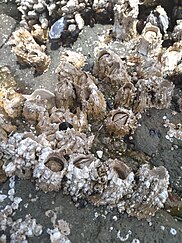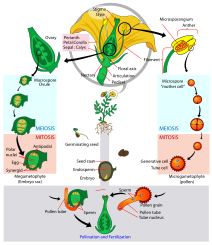Sexual system

Asexual systemis a distribution ofmaleandfemalefunction across organisms in aspecies.[1][2]The termsreproductive systemandmating systemhave also been used as synonyms.[3]
Sexual systems are a key factor forgenetic variationandreproductive success,and may also have led to the origin orextinctionof certainspecies.[4]The distinctions between different sexual systems is not always clear due tophenotypic plasticity.[2]
Interests in sexual systems go back toDarwin,who found thatbarnaclescontain species that areandrodioeciousand some that aredioecious.[5]
Types of sexual systems
[edit]
Flowering plantsmay havedimorphicormonomorphic sexual systems.In monomorphic sexual systems, a combination ofhermaphrodite,male,and/orfemaleflowersmay be present on the same plant. Monomorphic sexual systems includemonoecy,gynomonoecy,andromonoecy,andtrimonoecy.Indimorphic sexual systems,individual plants within a species only produce one sort of flower, either hermaphrodite or male, or female. Dimorphic sexual systems includedioecy,gynodioecy,androdioecy,andtrioecy.[6]
Male (a.k.a.staminate) flowers have astamenbut nopistiland produce only male gametes. Female (a.k.a. pistillate) flowers only have a pistil. Hermaphrodite (a.k.a. perfect, or bisexual) flowers have both a stamen and pistil. The sex of a single flower may differ from the sex of the whole organism: for example, a plant may have both staminate and pistillate flowers, making the plant as a whole a hermaphrodite. Hence although all monomorphic plants are hermaphrodites, different combinations of flower types (staminate, pistillate, or perfect) produces distinct monomorphic sexual systems.[7]
In animals,androdioecy,gynodioecy,andtrioecyare referred to asmixed sexual systems;[8]wherehermaphroditescoexist with single sexed individuals.[9]
List of sexual systems
[edit]| Sexual system | Description |
|---|---|
| Androdioecy | males and hermaphrodites coexist in a population.[10]It is rare in both plants and animals.[11] |
| Andromonoecy | rare sexual system inangiosperms,in which a plant has both male and hermaphroditic flowers.[12]It has been a subject of interest regarding the mechanism of sex expression.[13] |
| Dichogamy | an individual plant produces either exclusively male or exclusively female flowers at different points in time.[14]It is thought the temporal separation of producing male and female flowers occurs to prevent self-fertilization,[15]however this is debatable as dichogamy occurs in similar frequency among species which are self-compatible and self-incompatible.[16] |
| Dioicy | one of the main sexual systems inbryophytes.[17]In dioicy male and female sex organs are on separategametophytes.[18] |
| Dioecy | a species has distinct individual organisms that are either male or female, i.e., they produce only male or only female gametes, either directly (in animals) or indirectly (in plants).[19] |
| Gonochorism | individuals are either male or female.[19]
The term "gonochorism" is usually applied to animals while "dioecy" is applied to plants.[20]Gonochorism is the most common sexual system in animals, occurring in 95% of animal species.[21] |
| Gynodioecy | females and hermaphrodites coexist in the same population.[10] |
| Gynomonoecy | defined as the presence of bothfemaleandhermaphroditeflowers on the same individual of a plant species.[22]It is prevalent inAsteraceaebut is poorly understood.[23] |
| Gynodioecy-Gynomonoecy | a sexual system for plants when female, hermaphrodite, and gynomonoecious plants coexist in the same population.[24]: 360 |
| Monoicy | one of the main sexual systems inbryophytes.[17]In monoicy male and female sex organs are present in the samegametophyte.[18] |
| Monoecy | a sexual system in which male and female flowers are present on the same plant. It is common inangiosperms,[25]and occurs in 10% of all plant species.[26][dubious–discuss] |
| Sequential hermaphroditism | individuals start their adult lives as one sex, and change to the other sex at a later age.[27] |
| Sequential monoecy | a confusing sexual system,[28]in which the combination of male, female, and hermaphrodite flowers presented changes over time.[29]For example, some conifers produce exclusively either male or female cones when young, then both when older.[30]Sequential monoecy can be difficult to differentiate from dioecy.[31]Several alternative terms may be used in reference to sexual systems involving temporal changes to sex presentation of a plant species (e.g. dichogamy, sequential hermaphroditism, sex change, paradioecy, diphasy).[32] |
| Simultaneous hermaphroditism | an individual can produce both gamete types in the same breeding season.[33]Simultaneous hermaphroditism is one of the most common sexual systems in animals (though far less common thangonochorism) and is one of the most stable.[34] |
| Synoecy | all individuals in a population of flowering plants bear solely hermaphrodite flowers.[27] |
| Trioecy | males, females, and hermaphrodites exist in the same population.[8]It is present in both plants and animals but is always extremely rare.[35]Trioecy occurs in about 3.6% of flowering plants.[36]Trioecy may infrequently be referred to as tridioecy.[37] |
| Trimonoecy | (also called androgynomonoecy) is when male, female, and hermaphrodite flowers are present on the same plant.[27][38]Triomonoecy is rare.[39] |
References
[edit]Footnotes
[edit]- ^Encyclopedia of Animal Behavior.Vol. 4. Academic Press. 2019-01-21. p. 584.ISBN978-0-12-813252-4.
- ^abLeonard 2019,p. 1.
- ^Cardoso, João Custódio Fernandes; Viana, Matheus Lacerda; Matias, Raphael; Furtado, Marco Túlio; Caetano, Ana Paula de Souza; Consolaro, Hélder; Brito, Vinícius Lourenço Garcia de (Jul–Sep 2018)."Towards a unified terminology for angiosperm reproductive systems".Acta Botanica Brasilica.32(3): 329–348.doi:10.1590/0102-33062018abb0124.ISSN0102-3306.S2CID91470660.
- ^Goldberg EE, Otto SP, Vamosi JC, Mayrose I, Sabath N, Ming R, Ashman TL (April 2017). "Macroevolutionary synthesis of flowering plant sexual systems".Evolution; International Journal of Organic Evolution.71(4): 898–912.doi:10.1111/evo.13181.PMID28085192.S2CID19562183.
- ^Yusa Y, Yoshikawa M, Kitaura J, Kawane M, Ozaki Y, Yamato S, Høeg JT (March 2012)."Adaptive evolution of sexual systems in pedunculate barnacles".Proceedings. Biological Sciences.279(1730): 959–66.doi:10.1098/rspb.2011.1554.PMC3259936.PMID21881138.
- ^Torices R, Méndez M, Gómez JM (April 2011)."Where do monomorphic sexual systems fit in the evolution of dioecy? Insights from the largest family of angiosperms".The New Phytologist.190(1): 234–248.doi:10.1111/j.1469-8137.2010.03609.x.PMID21219336.
- ^Jabbour, Florian; Espinosa, Felipe; Dejonghe, Quentin; Le Péchon, Timothée (2022-01-07)."Development and Evolution of Unisexual Flowers: A Review".Plants.11(2): 155.doi:10.3390/plants11020155.ISSN2223-7747.PMC8780417.PMID35050043.
- ^abOyarzún PA, Nuñez JJ, Toro JE, Gardner J (2020)."Trioecy in the Marine Mussel Semimytilus algosus (Mollusca, Bivalvia): Stable Sex Ratios Across 22 Degrees of a Latitudinal Gradient".Frontiers in Marine Science.7.doi:10.3389/fmars.2020.00348.ISSN2296-7745.
- ^Leonard J, Cordoba-Aguilar A (2010-07-19).The Evolution of Primary Sexual Characters in Animals.Oxford University Press, USA. pp. 29–30.ISBN978-0-19-532555-3.
- ^abFusco G, Minelli A (2019-10-10).The Biology of Reproduction.Cambridge University Press. pp. 132–133.ISBN978-1-108-49985-9.
- ^Pontarotti P (2011-07-20).Evolutionary Biology – Concepts, Biodiversity, Macroevolution and Genome Evolution.Springer Science & Business Media. p. 36.ISBN978-3-642-20763-1.
- ^Casimiro-Soriguer R, Herrera J, Talavera S (March 2013). "Andromonoecy in an Old World Papilionoid legume, Erophaca baetica".Plant Biology.15(2): 353–9.doi:10.1111/j.1438-8677.2012.00648.x.PMID22823201.
- ^Pugnaire F, Valladares F (2007-06-20).Functional Plant Ecology.CRC Press. p. 524.ISBN978-1-4200-0762-6.
- ^Lloyd, David G.; Webb, C. J. (1986-07-01)."The avoidance of interference between the presentation of pollen and stigmas in angiosperms I. Dichogamy".New Zealand Journal of Botany.24(1): 135–162.Bibcode:1986NZJB...24..135L.doi:10.1080/0028825X.1986.10409725.ISSN0028-825X.
- ^Renner, Susanne S. (2014-10-01)."The relative and absolute frequencies of angiosperm sexual systems: Dioecy, monoecy, gynodioecy, and an updated online database".American Journal of Botany.101(10): 1588–1596.doi:10.3732/ajb.1400196.PMID25326608.
- ^Bertin, Robert I. (1993-05-01)."Incidence of Monoecy and Dichogamy in Relation to Self-Fertilization in Angiosperms".American Journal of Botany.80(5): 557–560.doi:10.1002/j.1537-2197.1993.tb13840.x.PMID30139145.
- ^abRamawat KG, Merillon JM, Shivanna KR (2016-04-19).Reproductive Biology of Plants.CRC Press. p. 62.ISBN978-1-4822-0133-8.
- ^abVillarreal JC, Renner SS (November 2013)."Correlates of monoicy and dioicy in hornworts, the apparent sister group to vascular plants".BMC Evolutionary Biology.13(1): 239.doi:10.1186/1471-2148-13-239.PMC4228369.PMID24180692.
- ^abKing RC, Stansfield WD, Mulligan PK (2007)."Gonochorism".A Dictionary of Genetics.Oxford University Press.doi:10.1093/acref/9780195307610.001.0001.ISBN978-0-19-530761-0.Retrieved2021-07-28.
- ^Encyclopedia of Evolutionary Biology.Vol. 2. Academic Press. 2016-04-14. p. 212.ISBN978-0-12-800426-5.
- ^Leonard JL (October 2013)."Williams' paradox and the role of phenotypic plasticity in sexual systems".Integrative and Comparative Biology.53(4): 671–88.doi:10.1093/icb/ict088.PMID23970358.
- ^Allaby M (2006)."Gynomonoecious".A Dictionary of Plant Sciences.Oxford University Press.doi:10.1093/acref/9780198608912.001.0001.ISBN978-0-19-860891-2.
- ^Martínez-Gómez P (2019-07-11).Plant Genetics and Molecular Breeding.MDPI. p. 442.ISBN978-3-03921-175-3.
- ^Lüttge, Ulrich; Cánovas, Francisco M.; Matyssek, Rainer (2016-05-27).Progress in Botany 77.Springer.ISBN978-3-319-25688-7.
- ^Bahadur B, Sujatha M, Carels N (2012-12-14).Jatropha, Challenges for a New Energy Crop: Volume 2: Genetic Improvement and Biotechnology.Springer Science & Business Media. pp. 27–28.ISBN978-1-4614-4915-7.
- ^Willmer P (2011-07-05).Pollination and Floral Ecology.Princeton University Press. p. 85.ISBN978-1-4008-3894-3.
- ^abcBeentje, Henk (2016).The Kew Plant Glossary(second ed.). Richmond, Surrey:Royal Botanic Gardens, Kew.ISBN978-1-84246-604-9.
- ^Putz, Francis E.; Mooney, Harold A. (1991).The Biology of Vines.Cambridge University Press. p. 411.ISBN978-0-521-39250-1.
- ^Flores-Rentería, Lluvia; Molina-Freaner, Francisco; Whipple, Amy V.; Gehring, Catherine A.; Domínguez, C. A. (2013-03-01)."Sexual stability in the nearly dioecious Pinus johannis (Pinaceae)".American Journal of Botany.100(3): 602–612.doi:10.3732/ajb.1200068.ISSN0002-9122.PMID23445824.
- ^Kang, Hyesoon (2007-04-01)."Changes in gender expression in korean populations ofPinus densiflora over a five-year period".Journal of Plant Biology.50(2): 181–189.doi:10.1007/BF03030628.ISSN1867-0725.S2CID19890328.
- ^Greenwood, Paul J.; Greenwood, Greenwood, Paul John; Harvey, Paul H.; Harvey, Reader in Biology Department of Zoology Paul H.; Slatkin, Montgomery; Slatkin, Professor of Integrative Biology Montgomery; Cambridge, University of (1985-07-11).Evolution: Essays in Honour of John Maynard Smith.CUP Archive. p. 240.ISBN978-0-521-25734-3.
{{cite book}}:CS1 maint: multiple names: authors list (link) - ^Windsor, Jon and Lesley Lovett-Doust Professor of Biology the University of (1988-07-07).Plant Reproductive Ecology: Patterns and Strategies: Patterns and Strategies.Oxford University Press, USA.ISBN978-0-19-802192-6.
- ^Leonard 2019,p. 14.
- ^Leonard J, Cordoba-Aguilar A (2010-07-19).The Evolution of Primary Sexual Characters in Animals.Oxford University Press, USA. p. 20.ISBN978-0-19-532555-3.
- ^Leonard 2019,p. 23.
- ^Albert B, Morand-Prieur MÉ, Brachet S, Gouyon PH, Frascaria-Lacoste N, Raquin C (October 2013)."Sex expression and reproductive biology in a tree species, Fraxinus excelsior L".Comptes Rendus Biologies.336(10): 479–85.doi:10.1016/j.crvi.2013.08.004.PMID24246889.
- ^Heikrujam, Monika; Sharma, Kuldeep; Prasad, Manoj; Agrawal, Veena (2015-01-01)."Review on different mechanisms of sex determination and sex-linked molecular markers in dioecious crops: a current update".Euphytica.201(2): 161–194.doi:10.1007/s10681-014-1293-z.ISSN1573-5060.S2CID254468003.
- ^Atwell BJ, Kriedemann PE, Turnbull CG (1999).Plants in Action: Adaptation in Nature, Performance in Cultivation.Macmillan Education AU. p. 244.ISBN978-0-7329-4439-1.
- ^Cardoso-Gustavson P, Demarco D, Carmello-Guerreiro SM (2011-08-06). "Evidence of trimonoecy in Phyllanthaceae: Phyllanthus acidus".Plant Systematics and Evolution.296(3): 283–286.doi:10.1007/s00606-011-0494-3.ISSN1615-6110.S2CID13226982.
Bibliography
[edit]Leonard, Janet (2019-05-21),Transitions Between Sexual Systems: Understanding the Mechanisms Of, and Pathways Between, Dioecy, Hermaphroditism and Other Sexual Systems,Springer Publishing,ISBN978-3-319-94139-4
